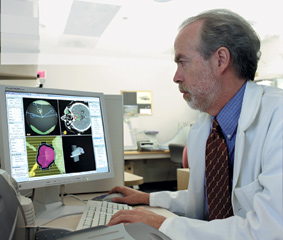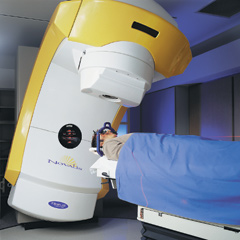Cutting-Edge Cancer Care
By Margot Mohsberg
Lucky for us,
clinical medical physicist Robert Siddon, Ph.D., fell victim to
Annapolis’ charm. But it wasn’t its bayside beauty
or its centuries-old history that caused him to plant roots in
the area. It was Anne Arundel Medical Center (AAMC) and its abounding
desire to offer cutting-edge cancer care to its patients. Dr.
Siddon believed he knew just the technology to do it. After all,
he helped create it.
 “At
the time, most of the advances in high-tech radiation therapy
that we had developed were only found in the large centers like
Harvard and the University of Texas’ M.D. Anderson Cancer
Center,” he says. Dr. Siddon says this meant a majority
of patients whose quality of life could have been improved dramatically
by this technology did not have access to it. Many community hospitals
simply could not afford the technology and didn’t have the
expertise to implement it. AAMC was different. “At
the time, most of the advances in high-tech radiation therapy
that we had developed were only found in the large centers like
Harvard and the University of Texas’ M.D. Anderson Cancer
Center,” he says. Dr. Siddon says this meant a majority
of patients whose quality of life could have been improved dramatically
by this technology did not have access to it. Many community hospitals
simply could not afford the technology and didn’t have the
expertise to implement it. AAMC was different.
“After a visit to AAMC, it became clear that we had an opportunity
to build a cancer center in Annapolis that would embrace technological
advances in a community hospital setting,” he says. “No
longer would patients in our community have to travel to D.C.
or Baltimore for quality care at a major center.”
Soon, Dr. Siddon and the AAMC administration set their goals even
higher. They wanted to lead a nationwide effort to offer high-tech
radiotherapies to more patients through community hospitals. “We
wanted our cancer center to serve as a model for other community
cancer centers,” he says.
Now, 15 years later, Dr. Siddon’s dream is coming true.
In June, AAMC will formally dedicate the Geaton A. and JoAnn DeCesaris
Cancer Institute. The institute, made possible by a $3 million
donation from the DeCesaris family, has already been named the
world’s first See and Treat Cancer Care Center of Excellence
for diagnosing and treating patients using the most advanced medical
imaging equipment from GE Healthcare and radiation therapy technologies
from Varian Medical Systems.
Many at AAMC believe the success of AAMC’s recent cancer
initiative is due in part to Dr. Siddon and the reputation he
holds in the medical community. Health care technology manufacturers,
such as GE, Varian and BrainLAB, Inc., are willing to bring their
newest equipment to AAMC because they know the hospital has the
knowledge to use it to its fullest advantage. Not only has Dr.
Siddon brought his own talents to AAMC, he also attracts other
doctors from across the country to the hospital. These medical
professionals come because they want to provide cutting-edge health
care services.
Twenty years ago, Dr. Siddon’s pioneering efforts at Harvard
Medical School brought about a revolutionary form of radiation
therapy called stereotactic radiosurgery. It was eventually developed
commercially and named Novalis in the late 1990s by BrainLab,
Inc. Novalis combines many precisely shaped radiation beams, each
directed toward the tumor but from a different angle. In doing
this, it is possible to achieve a tumor-killing dose where the
beams intersect while leaving healthy tissue unharmed. This outpatient
process is totally non-invasive, and most patients can return
to their normal routine the following day.
This unique therapy has become the number- one choice for non-invasive
removal of tumors of the brain, lung, head and neck, spine, liver
and prostate. Due to the efforts of Dr. Siddon, AAMC was one of
the very first hospitals in the country to offer this latest technology.
“Bob Siddon is internationally known for his contribution
to the development of this amazing technology,” says neurosurgeon
Thomas Ducker, a member of AAMC’s medical staff and partner
of the Maryland Neurological Institute. “His role as a key
member of AAMC’s oncology team makes it possible for the
hospital to offer the same level of advanced treatment with Novalis
as the major teaching hospitals.”
Dr. Siddon first set foot in Annapolis the same way many of its
residents do—the Navy. He grew up in the Pacific Northwest,
attending Washington State University and the University of Washington,
where he earned his doctorate in theoretical physics.
It was clear from the beginning of his college career that he
was born to do physics. Where other people saw a maze of numbers
and symbols, he viewed the same with clarity and understanding.
“After a year and a half of general classes, I finally took
a physics course as a science elective,” he says. “It
turned out to be the easiest class I had ever taken in school.”
After earning his doctorate, Dr. Siddon, who had joined the Naval
Reserve in high school, left Seattle and came East to teach physics
at the Naval Academy as a young lieutenant. His affection for
Annapolis was immediate.
“It was the fall of 1973, and I stepped off the plane at
Friendship Airport [now BWI] and took the shuttle down to Annapolis,”
he says. “My initial impressions were, well, just overwhelming—the
brick streets, the houses from the 1600s and 1700s, the State
House, George Washington.”
Dr. Siddon eventually discovered the King of France Tavern where,
that night, famed jazz musician Charlie Byrd “was playing
one of Bach’s toccatas and fugues…on a guitar.”
Dr. Siddon was so impressed, he decided to take lessons at the
Charlie Byrd studio. He also found an apartment on Maryland Avenue,
an 8-minute walk to his classroom at the Academy’s Michelson
Hall. “I had no doubt in my mind,” he says. “Annapolis
and I were made for each other.”
While teaching at the Academy, a close friend of Dr. Siddon’s
developed Hodgkin’s disease and began receiving radiation
treatments. Determined to understand what radiation had to do
with Hodgkin’s disease, Dr. Siddon took a course in physiology
at Johns Hopkins University. His friend recovered, but Dr. Siddon’s
thirst for understanding was unquenched.
Several years later he was offered a three-year fellowship at
Harvard Medical School in which people with science backgrounds
were trained in medicine in an effort to bridge the gap between
emerging technology and traditional medicine. “For me, this
was just what the doctor ordered,” Dr. Siddon says.
With this new knowledge, he eventually became chief of clinical
physics at Harvard Medical School and associate professor of health
sciences and technology at M.I.T.
In 1984, while at Harvard, he and a group of colleagues, including
radiation therapist Jay Loeffler, M.D., and neurosurgeon
Eben Alexander II, M.D., embarked on the daunting task to determine
how to do stereotactic radiosurgery. While there were many minor
obstacles, the major hurdle was that computers and imaging devices
were very limited at the time and delivered nothing like the three-dimensional
images seen today. In addition, small radiation beams were not
well-understood.

Patients receiving Novalis non-invasive radiosurgery are able
to go home that day.
“Basically, we had to make up in clever mathematical algorithms
what we lacked in technology at the time. After a year of unproductive
but all-consuming thought about the problem, I simply woke up
one morning and had the solution,” Dr. Siddon says. “After
a day to write it down and test it out, we were finally ready
to treat our first patient, which we did in 1986.”
By 1989, Harvard had treated the first 100 patients, and Dr. Siddon
was ready for a new challenge.
“My interests are not in the commercial development of products,”
Dr. Siddon says. “I find the process much too defined. What
I enjoy are the challenging problems, those at the cutting edge,
those that are waiting for a creative, not so obvious solution.”
On a return trip to Annapolis in 1989, part of his two-week summer
duty in the Naval Reserve, he discovered that AAMC was building
a new radiotherapy center on Jennifer Road. After meeting with
AAMC former president Chuck Brunetto and current president Martin
L. Doordan, the idea for the DeCesaris Cancer Institute emerged.
Since that day, Dr. Siddon has never looked back.
“I think we have come a long way since then,” he says
proudly.
Margot Mohsberg is a resident of Eastport and a freelance writer in addition
to being the media relations associate for Anne Arundel Health System.
|
Back
|

